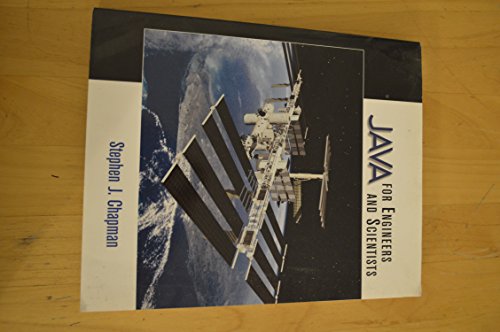Items related to Java for Engineers and Scientists

Synopsis
Develops and implements practical examples that demonstrate solving problems with Java in an engineering/science environment. Exemplifies software development practices. Softcover. DLC: Java (Computer program language)
"synopsis" may belong to another edition of this title.
About the Author
STEPHEN J. CHAPMAN is an Electrical Engineer with a specialty in Digital Signal Processing and Radar Systems. His career has included more than 20 years of experience writing large programs in Defense and Seismic Signal Processing environments. His projects have included real-time radar programming for M.I.T.'s Lincoln Laboratory; developing seismic signal processing algorithms for Shell Oil Company and large simulation programs for British Aerospace Australia.
He has taught Electrical Engineering and Electrical Technology Programs at the University of Houston and Computer Science in the Pacific Division of the University of Maryland.
STEPHEN J. CHAPMAN is an experienced author with several books already to his credit, including his first book with Prentice Hall, an E-Source title, Introduction to Java.
From the Back Cover
From the beginning, this book carefully develops and implements practical examples that demonstrate solving problems with Java in an engineering/science environment. This introductory text exemplifies excellent software development practices. Chapman uses a top-down design technique to show the reader how to create logical program modules. The author demonstrates object re-usability by building later examples on the classes and methods created in earlier examples. Finally, the approach emphasizes how to write reliable Java programs. This book makes learning an interactive experience by providing all sources for all examples through a Website.
- Leads students or professionals into problem solving without unnecessary Java language details
- Provides Java class libraries emphasizing the re-usable nature of objects derived from Java classes
- Provides a set a flexible graphics classes, allowing students to easily display and print graphical data in their programs
- Provides classes of practical use to Engineers and Scientists, such as classes to format numbers for display, to perform array-based operations, and to perform useful algorithms such as FFTs, correlation, and convolution
- Includes supplemental material in hard copy and on-line sources
"About this title" may belong to another edition of this title.
(No Available Copies)
Search Books: Create a WantCan't find the book you're looking for? We'll keep searching for you. If one of our booksellers adds it to AbeBooks, we'll let you know!
Create a Want
